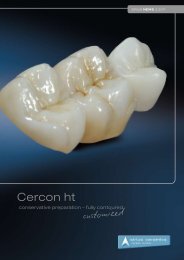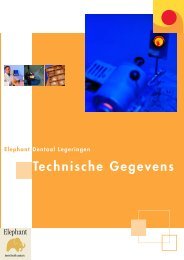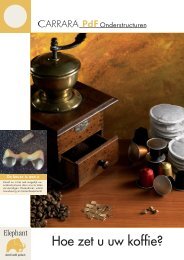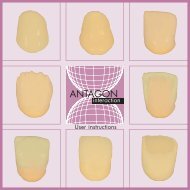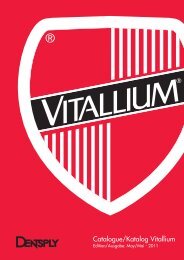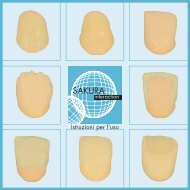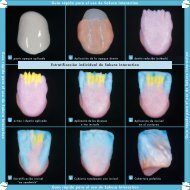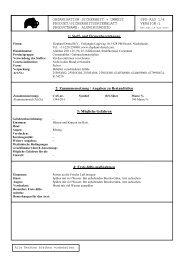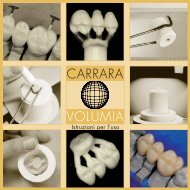DIRECTIONS FOR USE MODE D'EMpLOI ISTRUzIONI pER L'USO ...
DIRECTIONS FOR USE MODE D'EMpLOI ISTRUzIONI pER L'USO ...
DIRECTIONS FOR USE MODE D'EMpLOI ISTRUzIONI pER L'USO ...
You also want an ePaper? Increase the reach of your titles
YUMPU automatically turns print PDFs into web optimized ePapers that Google loves.
EINSTELLUNgENDENTSpLYAUSTENALECMIVgUSSgERÄTEinstellung Gießtemperatur:. .....1550ºC Vitallium-SkalaHaltezeit-Timer:...........................................5 SekundenSchmelz-Wahlschalter: ..........................Auf High (Hoch)EINSTELLUNgFLAMMEN-gUSSgERÄT:Kleine Gussobjekte - 50 Großes Gussobjekt - 75 bis 100UPM: 380-400Das Gegengewicht des Zentrifugalarms auf die korrektePosition einstellen, um für einen reibungslosen undbalanciertenGussvorgang zu sorgen. Befolgen Sie die Anweisungenfür das von Ihnen verwendete Gussgerät. Die Legierungschmelzen, in die vorgewärmte Muffel gießen und dieMuffel vor der weiteren Verarbeitung auf demArbeitstisch abkühlen lassen.MUFFELN NICHT RASCH ABKÜHLEN ODER ABSCHRECKEN,DA DIES ZU EINEM VERZIEHEN DER GUSSOBJEKTE & UNDUNERWÜNSCHTEN VERÄNDERUNGEN DER MECHANISCHENEIGENSCHAFTEN DER LEGIERUNG FÜHREN KANN.ANWEISUNgFüRDASgIESSENMITOFFENERFLAMMEWarnhinweise:Beim Schmelzen und Gießen mit offenerFlamme äußerste Vorsicht walten lassen. DieAnweisungen und Warnhinweise des Brenner-Herstellersbefolgen und bei der Verwendung eines Propan-Sauerstoff-Brenners einen speziell hierfür entwickeltenAugenschutz tragen.Je nach Spannung der Feder 3-5 Umdrehungen amGussarms verwenden. Das Gegengewicht entsprechendder Größe des zu gießenden Objekts auf die korrektePosition einstellen.Druckregler und Durchflussmesser für Sauerstoff-Acetylen-Schmelzbrenner verwenden.Vorgewärmte Muffel und Gusstiegel in das Gussgerätsetzen. Erforderliche Menge der Gusslegierung in denTiegel geben. Brenner anzünden und die Flammelangsam und kreisförmig über das Metall bewegen. DieseBewegung fortsetzen, um die Legierung gleichmäßig zuerhitzen und zu schmelzen. Wenn die Legierung zuschmelzen beginnt, fallen die Gusswürfel und Gusskegelzusammen. Die Legierung weiter gleichmäßig erhitzen,bis zu sehen ist, wie die geschmolzene Legierungzusammenfließt und sich unter dem Druck der Flammebewegt. Die Legierung NICHT überhitzen.Anmerkung:DerOxidfilmsolltenichtreißen.Den Gussarm freigeben und schleudern lassen, bis erzum Stillstand gekommen ist. Muffel herausnehmen undvor der weiteren Verarbeitung auf dem Arbeitstischabkühlen lassen.MUFFELN NICHT RASCH ABKÜHLEN ODER ABSCHRECKEN,DA DIES ZU EINEM VERZIEHEN DER GUSSOBJEKTE & UNDUNERWÜNSCHTEN VERÄNDERUNGEN DER MECHANISCHENEIGENSCHAFTEN DER LEGIERUNG FÜHREN KANN.AUSARbEITENUNDObERFLÄCHENpRÄpARATIONBei der Oberflächenpräparation sowie der Herstellungchirurgischer Implantate ist die Standard-Praxis gemäßASTM 86-84 in Bezug auf empfohlene Reinigungs- undPassivierungsverfahren zu befolgen.pHYSIKALISCHE&MECHANISCHEEIgENSCHAFTEN0,2- %-Dehngrenze ..........................................572 MPaZugfestigkeit....................................................799 MPaElastizitätsmodul..............................................200 GPaBruchdehnung..................................................... 7,0 %Vickers-Härte ...................................................410 HV5Dichte ........................................................... 8,3 g/cm 3Farbe ..................................................................... grauSchmelzintervall ......................................1300-1370 °Czusammensetzung(gewichts%)Kobalt ................................................................61,6 %Chrom ................................................................29,5 %Molybdän.............................................................6,5 %Mn, Si, C < 1,0%Die Legierung Vitallium Special enthält weder Nickelnoch Beryllium.IndicacionesLa aleación especial Vitalliun es una aleación demetales básicos predominantemente que está indicadapara el moldeado de los implantes subperiósticos.Contraindicaciones1. La aleación Vitallium Special está contraindicada enpacientes y usuarios con antecedentes desensibilidad al cobalto, cromo y molibdeno.Advertencias1. La exposición prolongada a los humos y/o polvos dela aleación puede causar irritación pulmonar y/ocomplicaciones pulmonares. Utilice los controles deingeniería apropiados para limitar la exposición. Enlos casos de excesiva inhalación de humos o polvos,busque atención médica.2. Esta aleación contiene cromo. Algunos compuestosde estos elementos tienen potencial carcinógeno.Informe a su proveedor médico de la exposición aestos elementos.3. Esta aleación contiene elementos conocidos enCalifornia por ser carcinógenos.precauciones1. Cuando funda, rebaje o pula aleaciones, utilice laventilación adecuada, sistemas de aspiración ovacío, protección ocular, y ropa y mascarillasprotectoras.Reaccionesadversas1. La exposición a los humos o al polvo de la aleaciónpuede causar irritación ocular y/o complicacionesrespiratorias.2. Determinados componentes de las aleacionestienen potencial carcinógeno. Vea el apartado“Advertencias”.INSTRUCCIONES PASO A PASOpROCESSINgINSTRUCTIONS:Recomendacionespararevestimiento:Utilice unsistema de revestimiento con silicato de etilo deDENTSPLY Austenal:Nº ref.Revestimiento VR .................. N022065, EU8022065VR Binder....................................N023001, EU8023005VR Binder Thinner .......................N024001, EU8024005Recomendacionesparaelmaterialdeduplicación:Use material reversible hidrocoloide de duplicaciónperflex® (nº ref. N021055) con el revestimiento VR.El material de duplicación Silflex® III de polivinil siloxano(nº ref. N021501) se recomienda para usarlo en laduplicación de modelos en moldes con dispositivos desujeción de precisión y para moldes de combinación.NOTA:Sigalasinstruccionesdelmaterialderevestimientoyduplicaciónqueestéutilizandoparamodelosrefractariosylospasosderevestimiento.EQUIpO:REQUISITOSDELHORNODEQUEMADO:pararevestimientoVR: Horno de gas de alta temperaturacapaz de alcanzar una temperatura de 1177 °C (2150 °F).MÁQUINASDE<strong>MODE</strong>LADO:Máquina de modelado DENTSPLY Austenal ECM IV o unaMáquina de modelado con soplete, esto es un soplete deoxígeno acetileno de múltiples orificios y brazo centrífugode modelado activado por resorte.INSTRUCCIONESDEQUEMADO:Precalentar los moldesde revestimiento y un crisol limpio de modelado siguiendoel ciclo recomendado de quemado para el revestimientoque se vaya a utilizar. Asegúrese de que los crisolessolamente se utilizan para esta aleación y que los crisolesutilizados no tienen escoria ni ningún resto de metal.INSTRUCCIONESDE<strong>MODE</strong>LADO:Relacióndemetalvirgen/reusado: Se recomienda metalvirgen 100% cuando se moldean implantes dentales.pARÁMETROSDELAMÁQUINADE<strong>MODE</strong>LADODENTSpLYAUSTENALECMIVAjuste de latemperatura de modelado: .......... 2820°F Vitallium ScaleTemporizador de remojo: ............................... 5 segundosSelector de fusión:..................................................... AltoAjustedelreductordeaceleración:Moldes pequeños - 50 Moldes grandes - 75 a 100RPM: 380-400Ajuste el peso del contador del brazo centrífugo en laposición adecuada para permitir una operación demodelado equilibrada y suave.Siga las instrucciones de la máquina que esté usando.Funda y modele la aleación en el molde precalentado derevestimiento y deje que los moldes se enfríen en la mesade trabajo antes de procesarlos más.NO FUERCE EL PROCESO DE ENFRIAMIENTO NI ENFRÍERÁPIDAMENTE LOS MOLDES YA QUE ESTO PODRÍACAUSAR LA DE<strong>FOR</strong>MACIÓN DE LOS MOLDES Y CAMBIOSNO DESEADOS EN LAS PROPIEDADES MECÁNICAS DELA ALEACIÓN.INSTRUCCIONESDE<strong>MODE</strong>LADOCONSOpLETE:Advertencia: Tenga extremo cuidado durante lasoperaciones de fusión con soplete. Siga las instrucciones yadvertencias del fabricante del soplete y utilice equipo deprotección para los ojos diseñado para utilizarlo cuandose use un soplete de oxígeno acetileno.Use 3-5 vueltas en el brazo de modelado dependiendo dela tensión del resorte. Ajuste las contrapesas en laposición correcta de acuerdo al tamaño del molde que sevaya a modelar.Coloque un soplete de oxígeno acetileno de múltiplesorificios con reguladores de presión y caudalímetros.Coloque el molde precalentado y el crisol en la máquinade modelado. Coloque la cantidad necesaria de aleaciónen el crisol.Encienda el soplete y con un movimiento circular, muevala llama lentamente sobre el metal. Continúe con estemovimiento para calentar y fundir uniformemente laaleación. Cuando la aleación empieza a fundirse, loslingotes y botones se colapsarán. Añada fundente y sigacalentando uniformemente la aleación hasta que puedaverse que la aleación fundida se desliza y mueve bajola presión de la llama. NO calentar excesivamentela aleación.Nota:Lapelículadeóxidonodeberomperse.Libere el brazo de modelado y deje que éste se paretotalmente. Retire el molde y deje que se enfríe en la mesade trabajo antes de procesarlo más.NO FUERCE EL PROCESO DE ENFRIAMIENTO NI ENFRÍERÁPIDAMENTE LOS MOLDES YA QUE ESTO PODRÍACAUSAR LA DE<strong>FOR</strong>MACIÓN DE LOS MOLDES Y CAMBIOSNO DESEADOS EN LAS PROPIEDADES MECÁNICAS DELA ALEACIÓN.pREpARACIóNDELASU<strong>pER</strong>FICIEYACAbADOConsulte en la práctica estándar ASTM 86-84 losprocedimientos recomendados de pasivación y limpiezapara la preparación de la superficie y creación deimplantes quirúrgicos.pROpIEDADESFÍSICASYMECÁNICASLímite de alargamiento 0,2% ......... 83.000 psi (572 MPa)Resistencia final a la tracción........ 116.000 psi (799 MPa)Módulo de elasticidad ....................29,000 kpsi (200 GPa)Porcentaje de elongación ......................................... 7,0%Dureza Vickers ................................................... 410 HV5Densidad............................................................. 8,3 g/ccIntervalo de fusión ...............1300-1370°C (2375-2500°F)Composición(%masa)Cobalto.................................................................. 61,6%Cromo.................................................................... 29,5%Molibdeno ............................................................... 6,5%Mn, Si, C < 1,0%La fórmula de la aleación Vitallium Special no contieneníquel ni berilio.IndicatiesVitallium Special is een kobalt basis legering in eersteinstantie voor het vervaardigen van subperiostealimplantaten.Contra-indicaties1. Vitallium Special niet gebruiken indien bekend is datde patiënt of gebruiker overgevoelig is voor kobalt,chroom en molybdeen.Waarschuwingen1. Langdurige blootstelling aan stof en/of dampen van delegering kunnen leiden tot irritatie van de longen en/oftot ademhalingsproblemen. Raadpleeg het veiligheidsinformatieblad voor meer informatie.2. Deze legering bevat chroom. Bepaalde chroom.verbindingen zijn mogelijk kankerverwekkend.Raadpleeg een arts wanneer blootstelling aan dezeelementen heeft plaatsgevonden.3. Deze legering bevat elementen die in de Amerikaansestaat Californië als kankerverwekkend gelden.Voorzorgsmaatregelen1. Zorg bij het smelten, beslijpen of polijsten vanlegeringen voor goede ventilatie en maak gebruik vaneen afzuiginstallatie. Draag bij bewerking eenbeschermende bril, een beschermend mondmasker enbeschermende kleding.bijwerkingen1. Blootstelling aan stof en/of dampen van de legeringkunnen leiden tot irritatie van de ogen en/of totademhalingsproblemen.2. Enkele bestanddelen van legeringen zijn mogelijkkankerverwekkend. Zie de waarschuwingen. Raadpleeghet veiligheidsinformatieblad.STAPSGEWIJZE AANPAKINSTRUCTIESVOORVERWERKINg:Adviezenvoorhetinbedden:Gebruik een ethylsilicaat gebonden inbedsysteem vanDENTSPLY Austenal: bestelnummers voor nabestellingenInbedsysteem:BestelnummerInbedmassa VR...........................N022065, EU8022065VR Binder .......................................N023001, EU8023005VR Binder Thinner...........................N024001, EU8024005Aanbevelingenvoorhetdupliceermateriaal:Gebruik bij Vitallium inbedmassa het perflex® reversibelehydrocolloïd-dupliceermateriaal (bestelnummer: N021055,EU8021055) met VR investment.Voor het dupliceren van modellen met precisieattachmentsen gecombineerde voorzieningen wordt hetpolyvinylsiloxaan-dupliceermateriaal Silflex® III(bestelnummer N021501) aangeraden. Voor EU gebruikersbevelen wij bij deze indicatie Silflex Blue (Shore25) Art.Nr.8021550-8021560 Componente A&B 5kg aan.OpMERKINg:Volgdeinstructiesvoorhetinbed-endupliceermateriaalopdatugebruiktvoorhetvuurvastemodelenhetinbedden.gIETMACHINES:De DENTSPLY Austenal ECM IV gietmachine of eenvlamgietapparaat, d.w.z. een centrifugale gietarm metveeractivering, met een propaan-zuurstof brander.INSTRUCTIESVOORHETVOORVERWARMEN: Verwarmde gietmoffels en een schone gietkroes conform de voor degebruikte inbedmassa aanbevolen voorverwarmcyclus.INSTRUCTIESVOORHETgIETEN: 100% nieuwe metaalis aanbevolen voor het gieten van dentale implantatenZorg dat eerder gegoten kegels en kanalen grondig wordengezandstraald en gereinigd voor dat ze opnieuw voor hetgieten worden gebruikt. Door dit advies op te volgen blijftde chemische samenstelling van de legering constant envormen zich zo min mogelijk oxiden en slakken (een vande hoofdoorzaken van insluitingen in gietobjecten).INSTELLINgENVANDEDENTSpLYAUSTENALECMIVgIETMACHINEInstelling giettemperatuur:..............1550ºC Vitallium-scalaTimer voor de houdtijd: ....................................5 secondenSmeltkeuzeschakelaar: ...............................Op hoog (high)INSTELLINgSlingergiet-apparaat:Kleine gietobjecten – 50, groot gietobject – 75 à 100Toerental: 380-400Stel het contragewicht van de centrifugearm in op de juistepositie, zodat een soepel en uitgebalanceerd gietprocédémogelijk is.Volg de instructies voor de door u gebruikte gietmachineop. Smelt de legering, giet hem in de voorverwarmdemoffel en laat de moffel voor verdere verwerking afkoelenop de werktafel.KOEL DE MOFFELS NIET SNEL AF EN LAAT ZE NIETAFSCHRIKKEN. DIT KAN VERVORMING VAN DEGIETOBJECTEN VEROORZAKEN EN KAN ONGEWENSTEMECHANISCHE VERANDERINGEN IN DE LEGERINGTEWEEGBRENGEN.INSTRUCTIESVOORHETgIETENMETOpENVLAM:Waarschuwingen: Ga bij het smelten en gieten met openvlam zeer voorzichtig te werk. Houd u daarbij aan deinstructies en waarschuwingen van de fabrikant van debrander en draag bij het werken met propaanzuurstofbranderseen speciale beschermingsbril.Werk, al naar gelang de spanning op de veer, metminimaal 3 tot 5 draaiingen van de centrifugearm. Stelhet contragewicht afhankelijk van de moffelgrootte van hette gieten object in op de juiste positie.Gebruik een propaan-zuurstoffbrander met drukregeling endebietmeter. Plaats de voorverwarmde moffel en degietkroes in het gietapparaat.Doe de juiste hoeveelheid van de gietlegering in desmeltkroes.Steek de brander aan en beweeg de vlam in langzaamdraaiende beweging over het metaal. Ga met dezebeweging door tot de legering gelijkmatig verwarmd is engaat smelten. Wanneer de legering begint te smelten,vallen de gietblokjes en gietkegels uiteen.Blijf de legering steeds gelijkmatig verhitten, tot devloeibare legering samenvloeit en zich onder de vlamdrukbeweegt. Zorg dat de legering NIET OVERVERHIT raakt!Opmerking:Deoxidefilmmagnietscheuren.Ontgrendel de gietarm en laat deze slingeren tot hij totstilstand is gekomen. Neem de moffel uit de brander enlaat hem op de werktafel afkoelen voordat er verder meewordt gewerkt.KOEL DE MOFFELS NIET SNEL AF EN LAAT ZE NIETAFSCHRIKKEN. DIT KAN VERVORMING VAN DE GIETOBJECTENVEROORZAKEN EN KAN ONGEWENSTE MECHANISCHEVERANDERINGEN TEWEEGBRENGEN IN DE LEGERING.FYSISCHEENMECHANISCHEEIgENSCHAppEN0,2-%-vloeigrens ..................................................572 MPaTreksterkte ...........................................................799 MPaElasticiteitsmodule ...............................................200 GPaBreekrek....................................................................7,0%Vickershardheid....................................................410 HV5Dichtheid............................................................8,3 g/cm 3Smeltinterval.................................................1300-1370°CSamenstelling(gewicht%)Kobalt......................................................................61,6%Chroom....................................................................29,5%Molybdeen................................................................ 6,5%Mn, Si, C < 1,0%De legering Vitallium Special bevat geen nikkel en geenberylliumAlloy/Alliage/Lega/Legierung/Aleación/Dentaal– giet- legeringDental Casting Alloy, Type 5Alliage de coulée dentaire, type 5Lega di fusione dentale, tipo 5Dentale Gusslegierung des Typs 5Aleación de moldeo dental, tipo 5Dentale gietlegering, Type 5ISO 22674<strong>DIRECTIONS</strong><strong>FOR</strong><strong>USE</strong><strong>MODE</strong>D’EMpLOI<strong>ISTRUzIONI</strong><strong>pER</strong>L’USOVERARbEITUNgSANLEITUNgINSTRUCCIONESDEEMpLEOWarning: This product contains substance(s)known to the State of California to cause cancer, orother reproductive harm. (Calif. Prop. 65)Avertissement : ce produit contient une ou dessubstance(s) reconnues par l’Etat de Californiecomme étant cause de cancer ou d’autre atteinteau système reproductif. (Calif. Prop. 65)Avvertenza: Questo prodotto contiene sostanzeche lo Stato della California considera cancerogeneo che possono provocare altri danni al sistemariproduttivo. (Calif. Prop. 65)Warnhinweis: Dieses Produkt enthält Substanzen,die im Staat Kalifornien als Ursache für Krebs oderandere Fortpflanzungsschäden bekannt sind. (Calif.Prop. 65)Advertencia: Esta producto contiene sustanciasconocidas en el estado de California por causarcáncer u otros daños en el aparato reproductor.(Calif. Prop 65)Waarschuwing: Dit product bevat stoffen die inde Amerikaanse staat Californië gelden alskankerverwekkend dan wel als oorzaak van anderevoortplantingsschade. (Calif. Prop. 65)ManufacturerDENTSPLY AustenalDENTSPLY International Inc.York, PA 17405-08721-800-243-1942www.prosthetics.dentsply.comwww.dentsply.comElephant Dental B.V.Verlengde Lageweg 101628 PM HoornThe Netherlands+31 229 25 90 00www.elephant.dental.comVitallium ® Trademark is licensed to DENTSPLY Austenalby SMD Corporation. Perflex ® , Polyflex ® , and Silflex ®are registered trademarks of DENTSPLY Austenal.La marque de commerce Vitallium ® est brevetéeAustenal DENTSPLY par SMD Corporation. Perflex ® ,Polyflex ® et Silflex ® sont des marques déposéesd’Austenal DENTSPLY.Il marchio registrato Vitallium ® è concesso in licenza aDENTSPLY Austenal da SMD Corporation. Perflex ® ,Polyflex ® e Silflex ® sono marchi registrati di DENTSPLYAustenal.Das Warenzeichen Vitallium ® ist lizenziert fürDENTSPLY Austenal durch die SMD Corporation.Perflex ® , Polyflex ® und Silflex ® sind eingetrageneWarenzeichen von DENTSPLY Austenal.SMD Corporation ha autorizado a DENTSPLY Austenalpara usar la marca comercial Vitallium ® . Perflex ® ,Polyflex ® y Silflex ® son marcas registradas deDENTSPLY Austenal.De merknaam Vitallium ® is gelicenseerd voorDENTSPLY Austenal door SMD Corporation. Perflex ® ,Polyflex ® en Silflex ® zijn gedeponeerde merknamenvan DENTSPLY Austenal.MSDS is available on the web or by request.Des fiches signalétiques et techniques sontdisponibles sur Internet ou sur demande.Le schede di sicurezza sono disponibili sul Web o surichiesta.MSDS (Material Safety Data Sheets,Sicherheitsdatenblätter) sind im Internet und aufAnfrage erhältlich.La ficha de datos sobre seguridad de materiales(MSDS) está disponible en la web o por petición.Het veiligheidsinformatieblad (VIB) is op internet enop aanvraag beschikbaar.©2006, 2011 DENTSPLY International Inc.All rights reserved.Made & Printed in U.S.A. NPK0877 Rev. F (08/11)
IndicationsVitallium Special Alloy is a predominantly base metalalloy indicated for casting subperiosteal implants.Contraindications1. Vitallium Special Alloy is contraindicated forpatients and users with a history of sensitivity tocobalt, chromium, and molybdenum.Warnings1. Prolonged exposure to alloy dust and/or fumes maylead to lung irritation, and/or pulmonarycomplications. Use appropriate engineering controlsto limit exposure. For excessive inhalation of dust orfumes, seek medical advice.2. This alloy contains chromium. Some compounds ofthis element are potential carcinogens. Advise yourhealth care provider of exposure to this element.3. This alloy contains elements that are known to theState of California to be carcinogenic.precautions1. When melting, grinding, or polishing alloys, useadequate ventilation, vacuum systems, protectiveeyewear, and protective masks and clothing.AdverseReactions1. Exposure to alloy dust or fumes may cause eyeirritation and/or respiratory complications.2. Certain components of alloys are potentialcarcinogens. See Warnings.STEP BY STEP INSTRUCTIONSpROCESSINgINSTRUCTIONSInvestmentRecommendations:Use DENTSPLY Austenal’s Ethyl Silicate BondedInvestment System:ReOrder#VR Investment ........................................... N022065VR Binder...................................................... N023001VR Binder Thinner.......................................... N024001DuplicatingMaterialRecommendations:Use perflex® Reversible Hydrocolloid DuplicatingMaterial (ReOrder# N021055) with VR Investment.Silflex® III Polyvinyl Siloxane Duplicating Material(ReOrder# N021501) is recommended for use for modelduplication for cases with precision attachments and forcombination cases.NOTE:Followtheinstructionsfortheinvestmentandduplicatingmaterialthatyouareusingforrefractorymodelandinvestingsteps.EQUIpMENTbURNOUTFURNACEREQUIREMENTSForVRInvestment:High temperature gas fired burnoutfurnace capable of attaining 2150°F (1177°C).CASTINgMACHINES: DENTSPLY Austenal ECM IVCasting Machine or a Torch Casting Machine - i.e.Oxygen acetylene multi-orifice torch & spring activatedcentrifugal casting arm.bURNOUTINSTRUCTIONS: Preheat the investmentmolds and a clean casting crucible following therecommended burnout cycle for the investment beingused. Make sure that crucibles are only used for thisalloy and that used crucibles are clean of slag and anyremaining metal.CASTINgINSTRUCTIONS: VirginMetal/RevertRatio:100% virgin metal is recommended when casting dentalimplants.DENTSpLY AUSTENALECMIVCASTINgMACHINESETTINgSCasting Temperature Setting: .... 2820°F Vitallium ScaleSoak Timer: ................................................. 5 secondsMelt Selector Switch:....................................... On HighAccelerationReducerSetting:Small Castings - 50 Large Casting - 75 to 100RPM: 380-400Adjust centrifugal arm counter weight to the properposition to provide for a smooth and balanced castingoperation.Follow the instructions for the machine that you areusing. Melt and cast the alloy into the preheatedinvestment mold and allow the molds to bench coolbefore further processing.DO NOT <strong>FOR</strong>CE COOL OR QUENCH THE MOLDS AS IT MAYCA<strong>USE</strong> WARPAGE OF THE CASTINGS & UNDESIRABLECHANGES IN THE MECHANICAL PROPERTIES OF THE ALLOY.TORCHCASTINgINSTRUCTIONS:Warning: Use extreme caution during torch meltingoperations. Follow the instructions and warnings of thetorch manufacturer and wear eye protection designedfor use when operating an oxygen acetylene torch.Use 3-5 turns on the casting arm depending on thetension of the spring. Set the counter weights at thecorrect position according to the size of the case tobe cast.Use a multi-orifice oxygen acetylene torch pressureregulators and flow meters.Place the preheated mold and crucible in the castingmachine. Place the required amount of alloy inthe crucible.Light the torch and with a circular motion move theflame slowly over the metal. Continue this motion touniformly heat and melt the alloy. When the alloybegins to melt, the ingots and buttons will collapse.Add flux and continue to uniformly heat the alloy untilthe molten alloy can be seen to slump and move underthe pressure of the flame. DO NOT overheat the alloy.Note:Theoxidefilmshouldnotbreak.Release the casting arm and allow the arm to coast to acomplete stop. Remove the mold and allow it to benchcool before further processing.DO NOT <strong>FOR</strong>CE COOL OR QUENCH THE MOLDS AS IT MAYCA<strong>USE</strong> WARPAGE OF THE CASTINGS & UNDESIRABLECHANGES IN THE MECHANICAL PROPERTIES OF THE ALLOY.FINISHINgANDSURFACEpREpARATIONRefer to ASTM 86-84 Standard Practice for surfacepreparation and making of metallic surgical implants forrecommended cleaning and passivation procedures.pHYSICAL&MECHANICALpRO<strong>pER</strong>TIES0.2% Yield Strength ................... 83,000 psi (572 MPa)Ultimate Tensile Strength ......... 116,000 psi (799 MPa)Modulus of Elasticity..................29,000 kpsi (200 GPa)Percent Elongation .............................................. 7.0%Vickers Hardness ........................................... 410 HV5Density ........................................................... 8.3 g/ccMelting Range ................. 2375-2500°F (1300-1370°C)Composition(%bymass)Cobalt (Co)............................................................. 61.6%Chromium (Cr)........................................................ 29.5%Molybdenum (Mo) .................................................... 6.5%Mn, Si, C < 1,0%Nickel and Beryllium Free AlloyIndicationsL’alliage spécial en vitallium est essentiellement un alliageen métal précieux indiqué pour la coulée des implantsjuxtaosseux.Contre-indications1. L’alliage Vitallium Special est contre-indiqué chez lespatients et les utilisateurs avec des antécédents desensibilités au cobalt, au chrome et au molybdène.Avertissements1. Une exposition prolongée aux poussières et auxvapeurs d’alliage peut entraîner une irritation despoumons et/ou des complications pulmonaires.Utilisez les moyens et équipements appropriés pourlimiter l’exposition. En cas d’inhalation excessive depoussières ou de vapeurs, consultez un médecin.2. Cet alliage contient du chrome. Certains composés decet élément sont cancérogènes. Informez votremédecin de votre exposition à cet élément.3. Cet alliage contient des éléments que l’Etat deCalifornie sait qu’ils sont cancérigènes.précautions1. Lors de la fonte, du meulage ou du polissage desalliages, utilisez une ventilation, des systèmes sousvide, des protections oculaires et des masques etvêtements de protection adéquats.Effetsindésirables1. L’exposition aux poussières ou aux vapeurs de l’alliagepeut entraîner une irritation oculaire et/ou descomplications pulmonaires.2. Certains composants de ces alliages sontcarcinogènes. Reportez-vous aux avertissements.INSTRUCTIONS PAS-À-PASINSTRUCTIONSRELATIVESAUTRAITEMENT:Recommandationsentermesderevêtement :Utiliser un système de revêtement lié au silicate d’éthyleAustenal de DENTSPLY :Nº de référenceRevêtement VR ........................... N022065, EU8022065VR Binder ........................................N023001, EU8023005VR Binder Thinner............................N024001, EU8024005Recommandationsentermesdematériaudeduplication:Utiliser un matériau de duplicationhydrocolloïde réversible perflex® (Nº de référenceN021055) avec revêtement VR.Il est recommandé d’utiliser le matériau de duplicationsiloxane de polyvinyle Silflex®III (Nº de référenceN021501) pour la duplication de modèle pour les prothèsesamovibles à fixations de précision et pour les prothèsesamovibles combinées.REMARQUE :Suivrelesinstructionsenmatièrederevêtementetdematériaudeduplicationencoursd’utilisationpourlesétapesderevêtementetdemodèleréfractaire.MATERIEL :CRITEREDUFOURDECHAUFFE :pourlerevêtementVR :Un four de chauffe au gaz hautetempérature capable d’atteindre 2150 °F (1177 °C).MACHINEACOULER : Machine à couler ECM IV AustenalDENTSPLY ou une machine à couler au chalumeau – àsavoir, un bras à couler centrifuge activé par ressort et auchalumeau à orifices multiples oxyacétylénique.INSTRUCTIONSDECHAUFFE : Préchauffer les moules derevêtement et un creuset propre pour coulée suivant lecycle de brûlage recommandé pour le revêtement utilisé.S’assurer que les creusets sont utilisés uniquement pourcet alliage et que les creusets utilisés sont exempts detoutes scories et de tout résidu de métal.INSTRUCTIONSDECOULEE : Rapportmétaldepremièrefusion/recyclage : Un métal 100 % pur est recommandélors de la coulée des implants dentaires.pARAMETRESDELAMACHINEàCOULERECMIVAUSTENALDENTSpLYParamètres detempérature de coulée : ..... Graduation Vitallium 2820°FMinuteur de trempage :...................................5 secondesCommutateur pour le choixdu mode de fusion :................................Sur High (élevé)pARAMèTRESDURéDUCTEURD’ACCéLéRATION :Petites pièces de coulé - 50Grandes pièces de coulée - 75 à 100 Tr/min. : 380-400Ajuster le contrepoids du bras centrifuge sur la positionadéquate afin de l’adapter à une opération de pièce decoulée homogène et équilibrée.Suivre les instructions correspondant à la machine encours d’utilisation. Fondre et couler l’alliage dans le moulede revêtement préchauffé et laisser les moules refroidiravant de poursuivre le traitement.NE PAS <strong>FOR</strong>CER LE REFROIDISSEMENT OU TREMPER LESMOULES. EN EFFET, CELA POURRAIT ENTRAINER UNGAUCHISSEMENT DES PIECES DE COULEE ET DESMODIFICATIONS INDESIRABLES DES PROPRIETESMECANIQUES DE L’ALLIAGE.INSTRUCTIONSDECOULEEAUCHALUMEAU :Avertissements: Procéder avec beaucoup de soin lorsdes opérations de fusion au chalumeau. Se conformer auxinstructions et avertissements du fabricant du chalumeauet porter des protections oculaires conçues pour êtreutilisées lors de l’utilisation d’un chalumeauoxyacétylénique.Utiliser 3–5 tours sur le bras à couler en fonction de latension du ressort. Définir le contrepoids sur la bonneposition selon la taille de la prothèse amovible à couler.Utiliser des débitmètres et régulateurs de pression dechalumeau oxyacétylénique à orifices multiples.Placer le moule et le creuset préchauffés dans la machine àcouler. Placer le volume requis d’alliage dans le creuset.Allumer le chalumeau et, d’un mouvement circulaire,déplacer doucement la flamme sur le métal. Poursuivre cemouvement pour chauffer et fondre uniformément l’alliage.Lorsque l’alliage commencera à fondre, les lingots etboutons s’effondreront. Ajouter du fondant et continuer àchauffer uniformément l’alliage jusqu’à ce que l’alliagefondu s’effondre et bouge visiblement sous la pression dela flamme. NE PAS surchauffer l’alliage.Remarque :Lacouched’oxydenedoitpassebriser.Relâcher le bras à couler et laisser le bras glisser jusqu’àl’arrêt complet. Enlever le moule et le laisser refroidir avantde poursuivre le traitement.NE PAS <strong>FOR</strong>CER LE REFROIDISSEMENT OU TREMPERLES MOULES. EN EFFET, CELA POURRAIT ENTRAINERUN GAUCHISSEMENT DES PIECES DE COULEE ETDES MODIFICATIONS INDESIRABLES DES PROPRIETESMECANIQUES DE L’ALLIAGE.IFINITIONETpRépARATIONDELASURFACEReportez-vous à ASTM 86-84 Standard Practice pour lapréparation des surfaces et la fabrication des implantsmétalliques chirurgicaux servant aux procédures denettoyage et de passivation recommandées.pROpRIETESpHYSIQUESETMECANIQUESLimite d’élasticité 0,2 %................. 83,000 psi (572 MPa)Force de traction ultime ................. 116,000 psi (799 MPa)Module d’élasticité .........................29,000 kpsi (200 GPa)Coefficient d’allongement ........................................ 7,0 %Dureté Vickers ..................................................... 410 HV5Densité ................................................................ 8,3 g/ccIntervalle de fusion........... 2375–2500 °F (1300–1370 °C)Composition(%delamasse)Cobalt .................................................................... 61,6%Chrome................................................................... 29,5%Molybdène ............................................................... 6,5%Mn, Si, C < 1,0%L’alliage Vitallium Special ne contient ni nickel nibéryllium.IndicazioniLa lega speciale di vitallio è una lega metallica di baseindicata oprattutto negli impianti sottoperiostei di fusione.Controindicazioni1. La lega Vitallium Special è controindicata nei pazientie utilizzatori con anamnesi di sensibilità al cobalto,cromo, e molibdeno.Avvertenze1. Una prolungata esposizione alle polveri/o vapori dellalega possono portare a irritazione e/o complicazionipolmonari. Adottare adeguati controlli tecnologici perlimitarne l’esposizione. In presenza di un’eccessivainalazione a polveri o vapori rivolgersi ad un medico.2. Questa lega contiene cromo. Alcuni composti di questielementi sono potenzialmente carcinogeni. Informare ilproprio medico curante dell’esposizione a questielementi.3. Questa lega contiene elementi noti come cancerogeniallo Stato della California.precauzioni1. Durante la procedura di fusione, molatura o lucidaturadi leghe, instaurare una ventilazione adeguata assiemea sistemi del vuoto e indossare occhiali, maschere eindumenti protettivi.Effetticollaterali1. L’esposizione a polveri e vapori della lega possonocausare irritazione oculare e/o complicazionirespiratorie.2. Certi componenti delle leghe sono potenzialmentecarcinogeni. Vedere Avvertenze.ISTRUZIONI FASE PER FASE<strong>ISTRUzIONI</strong>DITRATTAMENTOSuggerimentisulrivestimento:Utilizzare un sistema di rivestimento fissato con etilsilicatoDENTSPLY Austenal:.Numero per il riordinoRivestimento VR..........................N022065, EU8022065VR Binder.......................................N023001, EU8023005VR Binder Thinner...........................N024001, EU8024005SuggerimentisulmaterialediduplicazioneUtilizzare il materiale di duplicazione idrocolloidalereversibile perflex® (numero per il riordino N021055) conrivestimento VR.Si consiglia di utilizzare il materiale di duplicazione inpolivinilsilossano Silflex® III (numero per il riordinoN021501) per la duplicazione di modelli per protesi conattacchi di precisione e per protesi combinate.NOTA:seguireleistruzionirelativealmaterialedirivestimentoediduplicazionechesistautilizzandoperilmodellorefrattarioelefasidirivestimento.ATTREzzATURAREQUISITIDEL<strong>FOR</strong>NODIpRERISCALDOperrivestimentoVR:forno di preriscaldo a gas ad elevatatemperatura in grado di raggiungere 1177°C (2150°F).MACCHINEDIFUSIONE: Macchina di fusione ECM IVDENTSPLY Austenal o una Macchina di fusione con cannelloossidrico- cioè braccio di fusione centrifugo attivato amolla e con cannello ossiacetilenico a uscite multiple.<strong>ISTRUzIONI</strong>DIpRERISCALDO: Preriscaldare i modelli dirivestimento ed un crogiuolo di fusione pulito attenendosi alciclo di preriscaldo consigliato per il rivestimento utilizzato.Assicurarsi che i crogiuoli vengano utilizzati solo perquesta lega e che quelli usati vengano ripuliti dalle scoriee da qualsiasi residuo metallico.<strong>ISTRUzIONI</strong>DIFUSIONE: rapportometallovergine/revert:Durante la fusione di impianti dentali siconsiglia l’utilizzo di metallo vergine al 100%.IMpOSTAzIONIDELLAMACCHINADIFUSIONEECMIVDENTSpLYAUSTENALImpostazione dellatemperatura di fusione: ................ 2820°F scala VitalliumTempo di immersione: ....................................... 5 secondiInterruttore del selettore di fusione:.......... su “High” (Alto)IMpOSTAzIONEDELRIDUTTOREDIACCELERAzIONE:Fusioni piccole - 50 Fusioni grandi - da 75 a 100Giri/min: 380-400Regolare il contrappeso del braccio centrifugo nellaposizione appropriata per garantire un’operazione difusione regolare e bilanciata.Seguire le istruzioni della macchina in uso. Fondere lalega nel modello di rivestimento preriscaldato e lasciarraffreddare i modelli prima di procedere.EVITARE DI RAFFREDDARE <strong>FOR</strong>ZATAMENTE O DI TEMPRARE I<strong>MODE</strong>LLI POICHÉ QUESTO POTREBBE DE<strong>FOR</strong>MARLI ECAUSARE CAMBIAMENTI INDESIDERABILI NELLE PROPRIETÀMECCANICHE DELLA LEGA.<strong>ISTRUzIONI</strong>DIFUSIONECONCANNELLOAvvertenza: durante le operazioni di fusione con cannelloprestare la massima attenzione. Seguire le istruzioni e leavvertenze del produttore del cannello e indossare gliocchiali protettivi previsti per l’utilizzo di un cannelloossiacetilenico.Applicare 3-5 rotazioni al braccio di fusione a secondadella tensione della molla. Impostare i contrappesi nellaposizione corretta a seconda delle dimensioni dellamuffola da fondere.Utilizzare i regolatori di pressione del cannelloossiacetilenico a uscite multiple e i flussometri.Collocare il modello e il crogiuolo preriscaldati nellamacchina di fusione. Mettere la quantità richiesta dilega nel crogiuolo.Accendere il cannello e con un movimento circolaremuovere lentamente la fiamma sul metallo. Continuarea muovere in modo da riscaldare e fondere in modouniforme la lega. Quando la lega inizia a fondere, ilingotti e le punte inizieranno a collassare. Aggiungerefondente e continuare a riscaldare uniformemente la legafino a quando questa, fondendosi, non inizierà ascorrere e a muoversi sotto l’azione della fiamma. NONsurriscaldare la lega.Nota:lapellicoladiossidonondovràrompersi.Rilasciare il braccio di fusione e lasciarlo andare fino alcompleto punto di arresto. Togliere il modello e lasciarloasciugare prima di procedere.EVITARE DI RAFFREDDARE <strong>FOR</strong>ZATAMENTE O DITEMPRARE I <strong>MODE</strong>LLI POICHÉ QUESTO POTREBBEDE<strong>FOR</strong>MARLI E CAUSARE CAMBIAMENTI INDESIDERABILINELLE PROPRIETÀ MECCANICHE DELLA LEGA.LUCIDATURAEpREpARAzIONEDELLASU<strong>pER</strong>FICIEPer le procedure consigliate di pulizia e di passivazionenella preparazione della superficie e fabbricaziuone diimpianti chirurgici metallici, consultare la ASTM 86-84Standard Practice.pROpRIETàFISICHEEMECCANICHEResistenza allo snervamento 0,2%... 83.000 psi (572 MPa)Limite di resistenza alla trazione ... 116.000 psi (799 MPa)Modulo di elasticità.................... 29,000 kpsi (200 GPa))Allungamento percentuale...................................... 7,0%Durezza Vickers ................................................ 410 HV5Densità.............................................................. 8,3 g/ccIntervallo di fusione ........... 1300-1370°C (2375-2500°F)Composizione(%permassa)Cobalto ................................................................ 61,6%Cromo .................................................................. 29,5%Molibdeno ............................................................. 6,5%Mn, Si, C < 1,0%La formulazione della lega Vitallium Special è priva dinickel o berillio.IndikationenVitallium-Speziallegierung ist eine Basismetall-Legierung,die in erster Linie für das Gießen von subperiostalImplantaten angewendet wird.Kontraindikationen1. Die Legierung Vitallium Special ist bei Patienten undAnwendern mit erwiesener Empfindlichkeit gegenKobalt, Chrom und Molybdän kontraindiziert.Warnhinweise1. Längere Exposition gegenüber Staub und/oderDämpfen der Legierung kann zu Lungenreizungund/oder Atemproblemen führen. DetaillierteInformationen entnehmen Sie bitte denSicherheitsdatenblättern.2. Diese Legierung enthält Chrom. Einige Bestandteiledieser Elemente sind potenziell karzinogen. Den Arztinformieren, wenn eine Exposition gegenüber diesenElementen erfolgt ist.3. Diese Legierung enthält Elemente, die demBundesstaat Kalifornien als karzinogen bekannt sind.Vorsichtsmaßnahmen1. Beim Schmelzen, Beschleifen oder Polieren vonLegierungen für entsprechende Belüftung sorgenund Absaugsysteme einsetzen. Schutzbrille,Atemschutzmaske und Schutzbekleidung tragen(siehe Sicherheitsdatenblatt).Nebenwirkungen1. Exposition gegenüber Staub oder Dämpfen derLegierung kann zu Augenreizungen und/oderAtemproblemen führen.2. Einige Bestandteile von Legierungen sind potenziellkarzinogen. Siehe Warnhinweise.SCHRITTWEISES VORGEHENVERARbEITUNgSANLEITUNg:EmpfehlungenzurEinbettung:Verwenden Sie ein DENTSPLY Austenal Ethylsilikat-Gebundenes Einbettsystem: NachbestellnummerEinbettmasse VR........................N022065, EU8022065VR Binder......................................N023001, EU8023005VR Binder Thinner .........................N024001, EU8024005EmpfehlungenfürDubliermaterial:Verwenden Sie perflex® Reversibles Hydrokolloid-Dubliermaterial (Nachbestellnr. N021055, EU8021055)mit VR Einbettmasse.Silflex® III Polyvinyl-Siloxan-Dubliermaterial(Nachbestellnr. N021501) wird für das Dublieren vonModellen bei Fällen mit Präzisionsgeschieben undKombinationsversorgungen empfohlen.Für EU Anwender empfehlen wir für diesenIndikationsbereich Silflex Blue (Shore 25)Art.Nr.8021550 -8021560 Componente A&B 5kg.ANMERKUNg:befolgenSiedieAnweisungendesHerstellersfürdasEinbett-undDubliermaterial,dasfürdieHerstellungderfeuerfestenModelleundzumEinbettenverwendetwird.gUSSgERÄTE:DENTSPLY Austenal ECM IV Gussgerät, oder Flammen-Gussgerät - d.h. Federaktivierter Zentrifugal-Gießarm mitSauerstoff-Propan-Brenner verwenden.ANWEISUNgENzUMVORWÄRMEN: Die Gussmuffelnund einen sauberen Gusstiegel nach dem für dieverwendete Einbettmasse empfohlenen Vorwärmzyklusaufheizen. Sicherstellen, dass Gusstiegel nur für dieseLegierung verwendet werden und gebrauchte Tiegel freivon Schlacke und jeglichen Metallresten sind.gUSSANLEITUNg:VerhältnisNeu-/Altmetall: BeimGießen von Zahnimplantaten wird Metall empfohlen, daszu 100 % neu ist.



